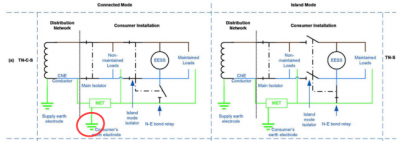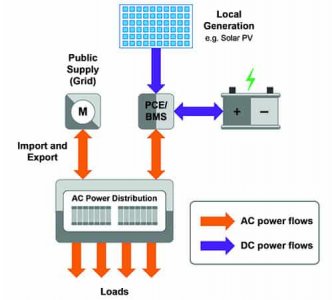Our experiences with solar pv, ASHP, battery, and EV: ourhomeelectric.co.uk
@steevjo That’s Ok Steevjo, fascinating reading and who would have thunked it that an ‘innocent’ question such as my Earth Bonding one would ‘spark’ off such a thread! I’m not sure I am able to say whether I should leave my gas pipe earth bond in place or not, but to be safe, I think I probably should - whether the connection now goes anywhere or not. I had a gas boiler, hob and the only other gas consuming device in the house was a radiant fire that is going out the door quite soon as it has been ousted by the air source heat pump anyway. Regards, Toodles.
Toodles, heats his home with cold draughts and cooks food with magnets.
Posted by: @steevjoMaybe I have found a spoiler!
I want to run this past my DNO engineering manager.
That article states
The earthing arrangement of most EESS in island mode, where the installation has a low voltage public supply connection, is therefore always TN-S.
But that's not within the province of the consumer to arrange!
Either the feed cable from the local substation has a combined earth & neutral, or else it has separate earth and neutral conductors.
That choice has already been made by the DNO.
If it's Combined (TN-C), then the consumer can't possibly use an earthing arrangement which is TN-S.
The diagrams in the article indicate that houses supplied using the TN arrangement
have their own earth stakes.
That's clearly not the case. Only a few do, and I can see those on NGED's maps.
@steevjo - I've now looked at your own house supply on the NGED mapping tool.
Neither you, nor any of your neighbours, have an earth connection to the ground.
It is provided solely by the centre tap of the substation transformer.
So that's an excellent example for me to discuss with their engineers!
Save energy... recycle electrons!
Posted by: @transparentThe diagrams in the article indicate that houses supplied using the TN arrangement
have their own earth stakes.
Only those that have batteries capable of operating when the grid is down
Posted by: @transparentI've now looked at your own house supply on the NGED mapping tool. Neither you, nor any of your neighbours, have an earth connection to the ground.
For sure I have an earth stake - added as part of the Powerwall battery installation. G99 connection was approved mid-March - presumably NGED haven't gotten around to updating the relevant record. Measured and included on the Electrical Installation certificate provided after the Powerwall installation.
Posted by: @transparentThe earthing arrangement of most EESS in island mode, where the installation has a low voltage public supply connection, is therefore always TN-S.
My reading of this is that when the grid is down the island is operating in TN-S mode - it can't rely on the incoming combined earth and neutral.
But, as I've said before, I'm just doing my best to understand - I don't really know!
Really appreciate your expert input.
Our experiences with solar pv, ASHP, battery, and EV: ourhomeelectric.co.uk
Posted by: @transparentPosted by: @transparentThe earthing arrangement of most EESS in island mode, where the installation has a low voltage public supply connection, is therefore always TN-S.
My reading of this is that when the grid is down the island is operating in TN-S mode
Hmmm. That's not what the author is claiming.
You can't implement an earthing arrangement which is always TN-S (ie based on Separate Earth & Neutral), if the feed belonging to the DNO is TN-C (Combined).
The separate earth wire isn't present in a TN-C feeder cable.
Save energy... recycle electrons!
@transparent The diagram in the article isn't saying the earthing arrangement is always TN-S, I think it's saying the earthing arrangement becomes TN-S when the grid is down and the isolators and bond relay have done their stuff. When the grid is operating normally the earthing arrangement is as shown in the connected mode diagram and is TN-C-S.
When the grid is down it could be for lots of reasons - one of which is the overhead cables to my house have been disconnected by a tree falling on them. At that point there really isn't a feed belonging to the DNO.
Our experiences with solar pv, ASHP, battery, and EV: ourhomeelectric.co.uk
Posted by: @transparent3: A gas pipe is still regarded as a gas pipe if the meter is removed.
4: To maintain earth continuity between two gas pipes which were originally connected via a meter, an earth-link is installed.
As it connects to the incoming service pipe, it is not your property and may not be disturbed or removed.
Re your earth bonding. I think the answer is in @transparent’s first reply. Leave it in place.
Our experiences with solar pv, ASHP, battery, and EV: ourhomeelectric.co.uk
@steevjo I intend to, untidy though it will be on the front of the house. There are various lengths of unused gas pipe under the floors going ‘nowhere’ - but at least they still have an earth bond! As the gas meter box disintegrated some years back and the flap was being held with a bamboo cane, I saw no reason to ask ‘someone’ (don’t know who that would be even) to replace repair the dilapidated box so it is now reduced to the back plate, piping, brackets and some heavy gauge earthing connections. A bushy plant will be grown in front of the remains of the box. Regards, Toodles.
Toodles, heats his home with cold draughts and cooks food with magnets.
Posted by: @steevjothe article isn't saying the earthing arrangement is always TN-S, I think it's saying the earthing arrangement becomes TN-S when the grid is down and the isolators and bond relay have done their stuff.
Erm... that's the point I'm making.
Earthing can't "become TN-S" unless there is a separate earth wire in the feed cable.
Perhaps the author is simply being too loose in terminology. Does he perhaps mean:
- the earthing becomes TN-S if the feed is TT or TN-S
- the earthing becomes TN-C if the feed is TN-C
"Becoming TN-S" implies that an earth wire suddenly appears in the feed for TN-S sites.
Either way, the phrase is confusing. We need to learn what the 'rules' are, and then come up with our own simple guideline...
... which I'm minded to be diagramatic in nature!
Let's look at this from the DNOs' viewpoint.
You only have to spend 5mins on this Forum to see that there is widespread failure to install renewable energy systems correctly.
To pick up just one technology, I have yet to read a description of a heat-pump site which actually complies with Building Regs Part-L (energy/heat).
Given this plethora of errors, how confident can we be that the installers have successfully implemented Part-P (electrical) in respect of the earthing arrangement?
Save energy... recycle electrons!
Let's pause for a moment whilst I lay out some of the issues I'm wanting to see clarified:
1: We are in the early days of seeing widespread roll-out of numerous new energy technology products which are installed in a home:
- Smart Meters
- PV Solar panel inverterss
- Heat Pumps
- EV chargers
- electricity storage batteries
If a house on a PME electricity feed installs more than one of these technologies, how may earth stakes would the home-owner expect to see?
I think the answer is 2, but that's what I want my DNO to clarify.
2: What's the situation if my Tesla Powerwall contains a double-pole isolation relay and a Neutral-earth bond relay, but my hybrid on/off-grid solar inverter does not?
Is the overall installation able to obtain consent from the DNO because the inverter's Neutral takes advantage of the N-E bond relay in the Powerwall?
And, if so, what's the situation if the Powerwall is faulty and has to be removed for a few days?
3: Since I have yet to learn of any heat pump site which fully complies with Building Regulations Part-L (heat).
What level confidence should the home-owner or Local Planning Authority have that the same installation complies with Part-P (electricity)?
If neither us consumers nor the LPA know enough to check these Building Regs notifications, why are we using taxes to pay for the service?
4: The IET guidance document we've been discussing here has a diagram which shows trips for mains appliances operating from the grid and others operating off-grid sharing the same consumer unit:
How is it OK for an electrician to work inside that unit?
Haven't we just devalued the requirement for a consumer unit to have a double-pole disconnector labelled MAIN SWITCH in red?
Save energy... recycle electrons!
@transparent Wot have I started (in my innocents, I might add!)?
Toodles, heats his home with cold draughts and cooks food with magnets.
A further (possible?) complication is about to rear its’ ugly head here; Virgin Media have informed us our telephone service is about to be changed and we will be provided with ‘adaptors’ to connect our telephones to our wif-fi equipment. I think that the present system has an earth connection alongside the telecommunications signal cable from the nearby street side connection box. I don’t know how this new system will work but suspect we are going to have to provide a 240v. mains supply to plug into. Might this external cable from the street side connection box also carry an ‘earth’? Regards, Toodles.
Toodles, heats his home with cold draughts and cooks food with magnets.
- 26 Forums
- 2,339 Topics
- 52.9 K Posts
- 480 Online
- 5,997 Members
Join Us!
Podcast Picks
Latest Posts
-

RE: The good, the bad and the not that great – my heat pump installation
@cathoderay Yes NAPIT do seem to impose deadlines on th...
By Burtis , 2 hours ago
-
RE: Configuration issues with 10kW Midea R32 heat pump
@cathoderay Thanks very much for your help. As you s...
By SteveT , 4 hours ago
-
@gery Sorry Gerry, mine is configured by adding an inte...
By Papahuhu , 4 hours ago
-
RE: Poll for Time of Use, tariffs, technology
Tarrifs seem limited to Octopus. Im with EON so voted ...
By JamesPa , 4 hours ago
-
Just wanted to acknowledge that @f1p has provided very ...
By Sheriff Fatman , 5 hours ago
-
@pie_eater Yes, I installed Homely to a Daikin heat pum...
By gery , 6 hours ago
-

RE: Setback savings - fact or fiction?
I have now done the analysis, but not for November 2025...
By cathodeRay , 6 hours ago
-
RE: British Gas vs Octopus Energy vs Heat Geek vs EDF vs Aira vs OVO vs EON.Next vs Boxt
Octopus estimated the heat loss at 7.8kw£5k50 deg at -3...
By stevettweed , 7 hours ago
-
RE: Havenwise App Help & Forum Support – Get the Most from Your Heat Pump
@davidalgarve Potentially stupid question, but are you ...
By Sheriff Fatman , 7 hours ago
-
RE: What a Bad Heat Pump Installation Looks Like
Spot on, for relatively little money, an air of ready "...
By Batpred , 8 hours ago
-
RE: Replacing my 18 month old Hitachi Yutaki ASHP
@trebor12345 Ok that makes more sense and leads is i...
By JamesPa , 14 hours ago
-
-

RE: Home energy storage & battery register
Now the proud owner of: 4.1Kw peak Aiko Neostar solar...
By TechnoGeek , 1 day ago
-
RE: Latest NIBE model has known defect and no solution
@kings I don’t I’m afraid as I submitted it through my ...
By richardpool , 1 day ago
-
-
RE: Aira Heat Pump: Stylish Scandinavian Heating
Aira called me back today, but not sure we got to the a...
By ChandyKris , 2 days ago
-
RE: Experience with Mitsu Par 50/60 Wireless Controller
The 27°C request doesn't boost the weather compensation...
By Sheriff Fatman , 3 days ago
-
RE: Getting the best out of a heat pump - is Homely a possible answer?
Oh and it was installed by Stevie Wonder!
By Grantmethestrength , 3 days ago







